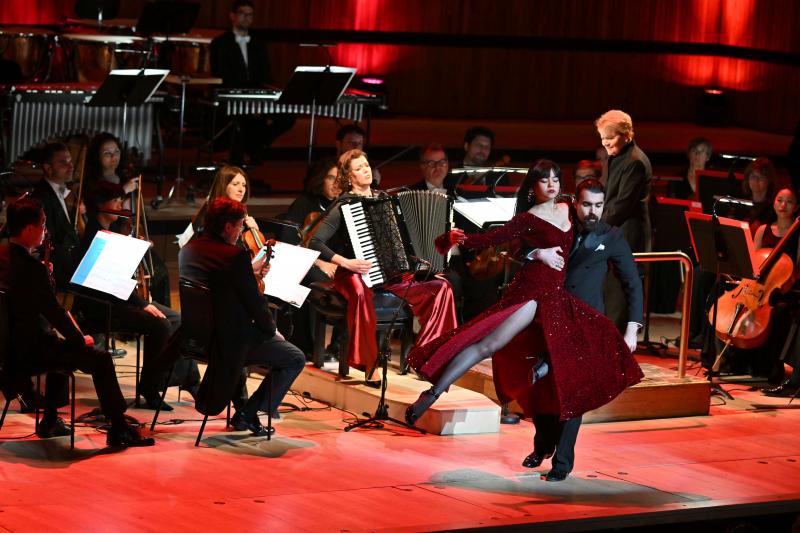Sidorova, Philharmonia, Alsop, Royal Festival Hall review – ladies of the dance | reviews, news & interviews
Sidorova, Philharmonia, Alsop, Royal Festival Hall review – ladies of the dance
Sidorova, Philharmonia, Alsop, Royal Festival Hall review – ladies of the dance
Vitality, virtuosity and sensuality on a pan-American trip

George Gershwin called one of his early classic songs, first created by Fred and Adele Astaire, “Fascinating Rhythm”. It was that mesmeric pull that propelled last night’s Royal Festival Hall Concert from the Philharmonia and its principal guest conductor, Marin Alsop. Every item might fit under the rubric of “dance-derived music of the Americas”, but beneath that broad-brimmed hat multiple genres leapt, strutted and twirled.
With music by Gershwin, Piazzolla, Bernstein and Brazilian composer Edu Lobo in her deft (but, notably, not hyper-active) hands, Alsop ruled over this repertoire with merry mastery. Of course she let the Philharmonia stretch a point, or a phrase, at times. But you heard the tight rein steering and shaping each work beneath the syncopated skips and slides – especially in the programme’s centre-piece: Piazzolla’s Aconcagua concerto. Originally written in 1979 for string orchestra and button-keyed bandoneón (the composer’s own instrument), it was played here on piano accordion by the remarkable Latvian virtuoso, Ksenija Sidorova.
The Aconcagua, named for an Argentinian mountain, proves just how high Piazzolla eventually aimed with the “Nuevo Tango” he pioneered in Buenos Aires from the late 1950s. Before the interval, Alsop and the Philharmonia swung, stretched and bounced through a trio of works that also thrive on those American dancefloors (North, Central and South) where pop and art music joyfully date. Gershwin’s Cuban Overture from 1932 featured some nattily delivered breaks and riffs (trumpets, trombones and woods), but it was the exhilarating battery of Afro-Cuban percussion – claves, maracas, gourds et al – that truly lifted the spirits. A string-led middle section veers into a New York bluesy mode, and even harks back to Spain, but Alsop brought us back to the Caribbean with the riotous rumba finale.
Alsop was having fun, but that firm hand never loosened for long. Before Bernstein’s Symphonic Dances from West Side Story, she even schooled the audience on how to follow her beat before shouting “Mambo!”. Did we do well? She should judge. The jabbing, swaggering prologue accelerated zestfully to its final police whistle, while the solo horn (Norberto López) brought aching tenderness to the first iteration of “Somewhere”. The fight scenes (“Cool”, “Rumble”) jumped and jangled with percussion-driven menace (hail to Matt Skelton on drums) while some creamy string playing – spearheaded by Philharmonia concert-master Zsolt-Tihamér Visontay – made sure that we never forgot the shamelessly romantic side of Bernstein’s musical persona.
Simon Haram’s alto sax, Samuel Coles’s flute, and Iain Clarke’s keyboards enriched a sonic streetscape that felt properly crowded but always clearly defined. Even when the band seemed to run wild – in the motoric frenzy of Edu Lobo’s three-minute Pé de Vento, with its helter-skelter onrush led by delightfully silly bassoons – the madness never lost its method. In this repertoire, on the fertile pan-American cusp between jazz, pop (of various kinds) and “classical” form, the effect of loose-limbed spontaneity is a highly discipled art, and one that Alsop dextrously commands.
 Piazzolla – sultry, subtle, full of ear-tingling surprises both rhythmically and harmonically – filled the second half. Alsop’s direction, and the Philharmonia’s playing, let us hear not just the fabled elevator of bar-and-bordello dance forms but the modernist-inflected student of Nadia Boulanger in Paris. Meanwhile, Ksenija Sidorova’s accordion both displayed its full-spectrum range of tone and colour but also summoned intriguing sororities that took us far from the realm of the humble squeezebox: think Baroque organ in Buenos Aires. Indeed, I felt that Piazzolla’s lush, almost Ravel-like string writing in the concerto’s opening allegro tended to drown the accordion’s wistful voice, until a cadenza-like section lets it roam, and shine, alone.
Piazzolla – sultry, subtle, full of ear-tingling surprises both rhythmically and harmonically – filled the second half. Alsop’s direction, and the Philharmonia’s playing, let us hear not just the fabled elevator of bar-and-bordello dance forms but the modernist-inflected student of Nadia Boulanger in Paris. Meanwhile, Ksenija Sidorova’s accordion both displayed its full-spectrum range of tone and colour but also summoned intriguing sororities that took us far from the realm of the humble squeezebox: think Baroque organ in Buenos Aires. Indeed, I felt that Piazzolla’s lush, almost Ravel-like string writing in the concerto’s opening allegro tended to drown the accordion’s wistful voice, until a cadenza-like section lets it roam, and shine, alone.
The central “moderato” feels like the emotional essence of this piece. Here, Piazzolla scales back the ripe orchestration as the accordion dialogues with piano, violin and harp (Elizabeth McNulty) in delicate, chamber-jazz intimacy. This magical hush allowed us to appreciate Sidorova’s ever-flexible control of the balance between right-hand melody and left-hand bass: again, more chamber organ than mere concertina. Rhythmic elasticity marked the performance but soloist, and conductor, never pushed the rubato tendencies too far. The presto finale gradually built in gravity and heft, with Antoine Siguré’s timpani to the fore, although another lightly-accompanied passage turned the spotlight back on Sidorova and her bittersweet, elusive keys.
Tango champs Bariki-Alaoui and Davlanti-Lo joined Sidorova for her solo performance of Piazzolla’s “Tanti Anni Primi”, then for John Lenehan’s full-dress orchestration of his iconic number “Libertango”. Inevitably, the two superbly accomplished dancers stole this last act of the show, but made visible as well the poise, restraint and sustained tension that can turn tango on this level into such a thrill. Both music and movement depend on delay, expectation and a taut yearning that Piazzolla’s sinewy, wandering lines arouse and then disperse. The most fascinating rhythms may tempt, hesitate, and tease, rather than blantantly swing or drive. Alsop, Sidorova and their dancers made that Valentine’s Day lesson gloriously, sensuously, clear.
rating
Share this article
The future of Arts Journalism
You can stop theartsdesk.com closing!
We urgently need financing to survive. Our fundraising drive has thus far raised £33,000 but we need to reach £100,000 or we will be forced to close. Please contribute here: https://gofund.me/c3f6033d
And if you can forward this information to anyone who might assist, we’d be grateful.

Subscribe to theartsdesk.com
Thank you for continuing to read our work on theartsdesk.com. For unlimited access to every article in its entirety, including our archive of more than 15,000 pieces, we're asking for £5 per month or £40 per year. We feel it's a very good deal, and hope you do too.
To take a subscription now simply click here.
And if you're looking for that extra gift for a friend or family member, why not treat them to a theartsdesk.com gift subscription?
more Classical music
 Sidorova, Philharmonia, Alsop, Royal Festival Hall review – ladies of the dance
Vitality, virtuosity and sensuality on a pan-American trip
Sidorova, Philharmonia, Alsop, Royal Festival Hall review – ladies of the dance
Vitality, virtuosity and sensuality on a pan-American trip
 MacMillan's Ordo Virtutum, BBC Singers, Jeannin, Milton Court review - dramatic journey of a medieval soul
Choral music's finest advocate runs the gamut in an epic battle of heaven and hell
MacMillan's Ordo Virtutum, BBC Singers, Jeannin, Milton Court review - dramatic journey of a medieval soul
Choral music's finest advocate runs the gamut in an epic battle of heaven and hell
 Braimah Kanneh-Mason, Fernandes, Gent, 229 review - a beguiling trip around the world
Engagingly humble and empathetic work from three talented musicians
Braimah Kanneh-Mason, Fernandes, Gent, 229 review - a beguiling trip around the world
Engagingly humble and empathetic work from three talented musicians
 Manchester Collective, RNCM review - something special in new music
Performers of extraordinary versatility fulfil their brief
Manchester Collective, RNCM review - something special in new music
Performers of extraordinary versatility fulfil their brief
 Classical CDs: Elephants, bells and warm blankets
Two great conductors celebrated, plus medieval choral music and an eclectic vocal recital
Classical CDs: Elephants, bells and warm blankets
Two great conductors celebrated, plus medieval choral music and an eclectic vocal recital
 Widmann, LSO, Pappano, Barbican review - razor-sharp attack in adrenalin charges
A great conductor continues his scorching survey of British symphonies with a hard-hitter
Widmann, LSO, Pappano, Barbican review - razor-sharp attack in adrenalin charges
A great conductor continues his scorching survey of British symphonies with a hard-hitter
 Nakariakov, SCO, Emelyanychev, Queen's Hall, Edinburgh review - a frenzied feast of contemporary classics
'New Dimensions' concerts continue to flourish
Nakariakov, SCO, Emelyanychev, Queen's Hall, Edinburgh review - a frenzied feast of contemporary classics
'New Dimensions' concerts continue to flourish
 Biss, BBCSO, Hrůša, Barbican review - electrifying Shostakovich at a crucial time
The Royal Opera's next music director achieves blazing results in a rich programme
Biss, BBCSO, Hrůša, Barbican review - electrifying Shostakovich at a crucial time
The Royal Opera's next music director achieves blazing results in a rich programme
 BBC Singers, Aurora Orchestra, Collon, Kings Place review - on the way to heaven via King's Cross
Intimate settings for a musical journey towards bliss
BBC Singers, Aurora Orchestra, Collon, Kings Place review - on the way to heaven via King's Cross
Intimate settings for a musical journey towards bliss
 Classical CDs: Mandolins, trumpets and hot soup
French chamber music, Viennese waltzes and a disc of viola duets
Classical CDs: Mandolins, trumpets and hot soup
French chamber music, Viennese waltzes and a disc of viola duets
 RAM Song Circle, Wigmore Hall review - excellent young musicians lift the spirits
Royal Academy singers revel in merry monks, mourning mothers and morose musings
RAM Song Circle, Wigmore Hall review - excellent young musicians lift the spirits
Royal Academy singers revel in merry monks, mourning mothers and morose musings

Add comment